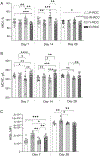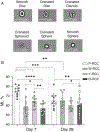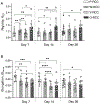Donor-dependent aging of young and old red blood cell subpopulations: Metabolic and functional heterogeneity
- PMID: 32812244
- PMCID: PMC7980132
- DOI: 10.1111/trf.16017
Donor-dependent aging of young and old red blood cell subpopulations: Metabolic and functional heterogeneity
Abstract
Background: Characteristics of red blood cells (RBCs) are influenced by donor variability. This study assessed quality and metabolomic variables of RBC subpopulations of varied biologic age in red blood cell concentrates (RCCs) from male and female donors to evaluate their contribution to the storage lesion.
Study design and methods: Red blood cell concentrates from healthy male (n = 6) and female (n = 4) donors were Percoll separated into less dense ("young", Y-RCCs) and dense ("old", O-RCCs) subpopulations, which were assessed weekly for 28 days for changes in hemolysis, mean cell volume (MCV), hemoglobin concentration (MCHC), hemoglobin autofluorescence (HGB), morphology index (MI), oxygen affinity (p50), rigidity, intracellular reactive oxygen species (ROS), calcium ([Ca2+ ]), and mass spectrometry-based metabolomics.
Results: Young RCCs having disc-to-discoid morphology showed higher MCV and MI, but lower MCHC, HGB, and rigidity than O-RCCs, having discoid-to-spheroid shape. By Day 14, Y-RCCs retained lower hemolysis and rigidity and higher p50 compared to O-RCCs. Donor sex analyses indicated that females had higher MCV, HGB, ROS, and [Ca2+ ] and lower hemolysis than male RBCs, in addition to having a decreased rate of change in hemolysis by Day 28. Metabolic profiling indicated a significant sex-related signature across all groups with increased markers of high membrane lipid remodeling and antioxidant capacity in Y-RCCs, whereas O-RCCs had increased markers of oxidative stress and decreased coping capability.
Conclusion: The structural, functional, and metabolic dissimilarities of Y-RCCs and O-RCCs from female and male donors demonstrate RCC heterogeneity, where RBCs from females contribute less to the storage lesion and age slower than males.
Keywords: RBC metabolomics; RBC morphology; RBC senescence; RBC storage lesion; young and old RBCs.
© 2020 AABB.
Conflict of interest statement
CONFLICT OF INTEREST
A.D. is a founder of Omix Technologies Inc and Altis Biosciences LLC, and a consultant for Hemanext Inc. The other authors declare that they have no conflicts of interest.
Figures






Comment in
-
You're only as old as you feel: Age is not just a number.Transfusion. 2020 Nov;60(11):2464-2465. doi: 10.1111/trf.16160. Transfusion. 2020. PMID: 33217021 No abstract available.
References
-
- World Health Organization. Global Status Report on Blood Safety and Availability. Geneva: World Health Organization; 2016. http://apps.who.int/bookorders. Accessed May 1, 2020.
Publication types
MeSH terms
Grants and funding
LinkOut - more resources
Full Text Sources
Medical
Research Materials
Miscellaneous

